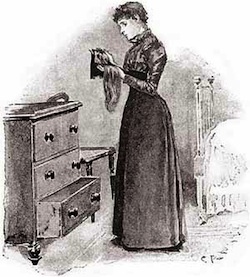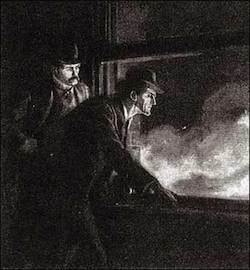Essentially, a good Sherlock Holmes story is more like a brain teaser and less like a Miss Marple whodunit. But instead of the reader playing along with the puzzle or brain teaser, the only person who truly has all the information is Holmes himself. The tension of the story relies not upon finding out if a reader’s guess is correct, but instead showing us how he sorts it all out.
In this way, Holmes did not solve mysteries, but instead had adventures. Proof? Most of the stories in the canon are proceded with the phrase “The Adventure of ” While not all stories fall into this kind of formula, the moments in which Holmes reveals a seemingly simple situation to actually be a complex one are among the best sorts of literary twists out there. Here are five such “Ah-ha!” moments from the world’s greatest, and only, consulting detective.
“The Adventure of the Speckled Band”
Miss Helen Stoner’s twin sister Julia Stoner has died a baffling death, with an even more baffling final gasp; the enigmatic “Oh, my God! Helen! I was the band. The speckled band!” Everyone, including Helen, attributes this last gasp to delusional death-throes babbling. But Holmes has other ideas. Lurking in the shadows is Dr. Roylott, the weird and brutal stepfather of the two women who owns the estate where Julia Stoner met her end. Roylott has populated the grounds of the estate with a number of exotic animals including a baboon and a cheetah. But it turns out there are also snakes on these grounds too.
The speckled band poor Julia referred to was a pattern on the skin of “swamp adder” a deadly snake Roylott has trained to respond to his whistling! Doyle at one point revealed he considered this story to be one of his favorites, and among Doyle scholars and fans it is certainly iconic. Sherlock’s big moment in this story comes when he realizes the snake was the murder weapon. The instant in which the reader and other characters are shown the snake, is the same scene in where Holmes flies into action to kill it.
Big revelation: the crazy things people say in moments of death sometimes translate to: “a snake killed me!”
“The Adventure of the Copper Beaches”

This story opens with a bizarre and seemingly innocuous mystery: Miss Violet Hunter has been given a great paying governess job, with one strange snag. She’s been required to cut her long red hair and been asked to sit by a certain window at particular times of the day. Though it’s weird, at first Miss Violet goes along with this until her employer, Mr. Rucastle starts getting super-rude with her. After visiting the Copper Beaches out near Winchester, Holmes notices a number of oddities, culminating in the realization that the floor plan of the house does not correspond with its size. Meaning? There is a secret room! Inside the secret room? Mr. Ruscaslte’s daughter, a woman with a striking resembles to Violet Hunter! It was all a plot to make a suitor of Ruscastle’s daughter think she was truly not interested, but still alive. Rucastle is a serious bastard, and also possesses a mean and nasty mastiff, which he threatens to sick on pretty much everybody. Famously Watson “blows its brains out” in the final scenes of the story. Whoa John Watson! Cold blooded badass. Violet Smith discovers someone else’s red hair…
Big revelation: If someone asks you to cut your awesome hair it probably means they want you to impersonate someone from afar.
“The Adventure of Silver Blaze”
 Who horse-napped Col. Ross’s prizewinning racehorse, Silver Blaze? It was a tricky job whoever did it, because the guard dog didn’t even bark. In fact, the well-known phrase of “the curious incident of the dog in the night time” is derived from this story. Inspector Gregory says to Holmes “but the dog did nothing in the night-time!” Holmes replies, “That was the curious incident.” The dog would have barked the night Silver Blaze was stolen, but it didn’t, meaning whoever took the horse was someone the dog knew. At the end of the story Holmes not only realizes the Silver Blaze heist was an inside job, but also the horse has been hidden in plain sight at a neighboring stable. The horse gets its name from a distinctive shock of silver/white running down his snout. No stranger to theatrical makeup himself, Holmes reveals a different plain horse to be a disguised Silver Blaze. In terms of awesome reveals, this story is slick for having two; the horse was stolen by and insder, and it was hanging out in plain sight. Interestingly, in the Jeremy Brett dramatization of this story, a young Jude Law had a small part as a man working in the stables. Was he taking notes from Edward Hardwicke on how to portray Watson?
Who horse-napped Col. Ross’s prizewinning racehorse, Silver Blaze? It was a tricky job whoever did it, because the guard dog didn’t even bark. In fact, the well-known phrase of “the curious incident of the dog in the night time” is derived from this story. Inspector Gregory says to Holmes “but the dog did nothing in the night-time!” Holmes replies, “That was the curious incident.” The dog would have barked the night Silver Blaze was stolen, but it didn’t, meaning whoever took the horse was someone the dog knew. At the end of the story Holmes not only realizes the Silver Blaze heist was an inside job, but also the horse has been hidden in plain sight at a neighboring stable. The horse gets its name from a distinctive shock of silver/white running down his snout. No stranger to theatrical makeup himself, Holmes reveals a different plain horse to be a disguised Silver Blaze. In terms of awesome reveals, this story is slick for having two; the horse was stolen by and insder, and it was hanging out in plain sight. Interestingly, in the Jeremy Brett dramatization of this story, a young Jude Law had a small part as a man working in the stables. Was he taking notes from Edward Hardwicke on how to portray Watson?
Big revelation: Curious incidents in the night-time often have more to do with what didn’t happen than what did.
“The Adventure the Man with the Twisted Lip”
Obviously, the notion of hidden identities and false personas is quite the recurring theme among some of the more memorable Sherlokian twists. Indeed it’s not inconceivable that an impressionable young mind, after reading the Holmes stories as they were published new, would start to see conspiracies everywhere. Like “Silver Blaze,” the story of a well-to-do beggar Hugh Boone in “The Man With the Twisted Lip” culminates in a hidden-in-plain sight mystery. After Neville St. Claire seemingly vanishes in a room above an opium den, his wife and Holmes initially suspect murder. But then the missing St. Claire starts writing letters to his wife. Meanwhile, the only witness to the supposed-crime is Hugh Boone, a well-known beggar around town. Among this sort of riff-raff, Boone is well liked by society owing primarily to his razor-sharp wit. But while imprisoned, the normally chatty Boone is mum on any details about what happened to St. Claire.
In a moment of inspiration, Holmes realizes Boone and St. Claire are one and the same. All that’s needed is a sponge and some water, and Holmes reveals a double-life. The problem is, “working” as a beggar is St. Claire’s only source of income! It turns out no crime has been committed, at least according to the law. In the end St. Claire is faced with the trouble of explaining to his wife just how they’ve been paying for all those fancy dinners.
Big revelation: Really clever beggars are probably non-homeless people trying to scam you.
“The Adventure of the Bruce-Partington Plans”
 Inspector Lestrade thinks this one is pretty cut and dry: Cadagon West-an employee of the British-government fell from a train while on his way to sell some secret submarine plans he recently stole. The only problem is he doesn’t have a ticket in his pocket for the train he supposedly fell from. Further, there isn’t really enough blood on his person to account for the cause of death being a fall from the train. So what really happened? Cadagon West didn’t die from a fall- he was murdered! After a thorough analysis of some train maps, Holmes determines there is only one place where a body could have been dropped to make it look as though it fell from the correct train. And that location points directly to the residence of an agent known to Holmes; Oberstein. Oberstein put West’s body on the top of a train at just the right moment to simulate a fall. This story illustrates well the wonderful blend between artist and scientist which Holmes embodies. He has to imagine a certain scenario from thin air. Then he tests the situation, and it turns out to be true. But without his imagination, he would have been lost. This, perhaps is indicative of a method Holmes applies maybe even more than deductive reasoning; inductive reasoning.
Inspector Lestrade thinks this one is pretty cut and dry: Cadagon West-an employee of the British-government fell from a train while on his way to sell some secret submarine plans he recently stole. The only problem is he doesn’t have a ticket in his pocket for the train he supposedly fell from. Further, there isn’t really enough blood on his person to account for the cause of death being a fall from the train. So what really happened? Cadagon West didn’t die from a fall- he was murdered! After a thorough analysis of some train maps, Holmes determines there is only one place where a body could have been dropped to make it look as though it fell from the correct train. And that location points directly to the residence of an agent known to Holmes; Oberstein. Oberstein put West’s body on the top of a train at just the right moment to simulate a fall. This story illustrates well the wonderful blend between artist and scientist which Holmes embodies. He has to imagine a certain scenario from thin air. Then he tests the situation, and it turns out to be true. But without his imagination, he would have been lost. This, perhaps is indicative of a method Holmes applies maybe even more than deductive reasoning; inductive reasoning.
Big revelation: Sometimes you have to imagine some really messed-up stuff in order to get to the truth.
Now, Sherlokians- tell me your favorite “Ah-ha’s!” The game is afoot!
Ryan Britt is the staff writer for Tor.com. He once deduced he was someone else but decieded to not report it to anyone.










For me, it will always be the reveal of the true purpose of The Red-Headed League. One, it had a bit of action, a bit of danger and was one of those “of course, it’s so simple” solutions. Two, it was the first Sherlock Holmes story I ever read (I was about 7 or 8) and the one that got me hooked on the good detective for life.
Stephen King’s “The Doctor’s Case” has a most excellent reveal. I won’t spoil it.
Typo note: it’s the Adventure of the Copper Beeches, not Cooper Beaches. A great story.
Have you read The Siam Question, by Timothy Francis Sheil? It is in my view the best of the pastiches and maintains the ‘adventure’ tradition highlighted in this post.
@3 Maybe it really was the “cooper beaches” and Watson just changed it to protect the real people invovled. ;-) (Thanks.)
My favorite is a sort of reverse “A-ha!” moment, the scene in The Hound of the Baskervilles on the moors at the old stone hut where Watson lies hiding in wait for the mysterious Man on the Tor (another escaped convict?), who, before entering the hut, calls out, “It’s a lovely evening, my dear Watson. I really think you will be more comfortable outside than in.” Thus, where Sherlock usually reveals the secret, here the secret reveals that it is Sherlock.